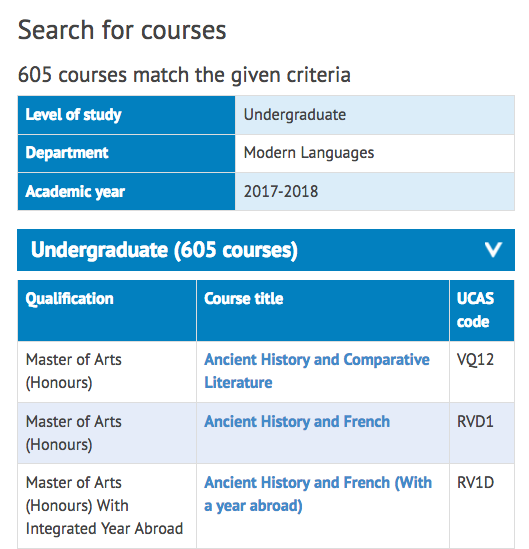Creating prototype UG course pages
The digital communications team is continuing with our digital prospectus project by developing undergraduate course pages. In a previous post, we described the rationale for creating UG pages with more tailored and targeted information, which would be listed by subject rather than department.
After conducting research (which included competitor analysis, prospective student and parent surveys, and a staff workshop), we came up with a prototype structure for each course page.
However, no two UG courses are the same, and many need special consideration. With the wide variety of different degree types, entry routes and course options, we came up with an array of ten different example prototypes to demonstrate how we would advertise different types of UG courses:
- single Honours – Arts
- single Honours – Science
- joint Honours – Arts
- joint Honours – Science
- joint Honours – three languages
- integrated year abroad
- Honours degree with a major
- Gateway degree
- direct entry to second year
- Medicine.
Single Honours
The two single Honours pages were the easiest to create. With only one subject to focus on for each, we were able to describe the courses in detail.
For the science programme, we found we needed an additional section about facilities. It is likely that for some single Honours courses, we will need to include additional sections highlighting key selling points (such as field trips, facilities or special modules).
Joint Honours
The joint Honours pages presented more of a challenge. While some joint degrees fit together easily – such as Art History and English, two culturally focused programmes – others have no obvious reason why a student would take the two subjects together, except out of personal interest (such as Biology and Geology).
This gets especially complicated when trying to advertise one of the Modern Languages joint degrees in which students take three different languages. By trying to roll three different subjects into a single coherent programme, we lost a lot of the content which highlights the uniqueness and individuality of each language.

Another problem with joint degrees is that they add an additional 800+ course pages that we would have to create. Although no definitive decision has yet been made about which UG courses will be included in the digital prospectus, a preferable option would be to only have single Honours pages which include a section about the joint Honours options for that course.
Integrated year abroad
On all of the other course prototypes, we include a section about study abroad options specifically related to that course. However, the integrated year abroad programme is different in that it is a five-year programme during which students spend one year at a work placement in a relevant country.
Besides the additional year, however, the programme is the same as any regular language course. Therefore, a preferable option would be to include a bit of text on the single Honours language course pages which links to a general page describing the specific details about the integrated year abroad option.
Honours degree with a major

As with the joint Honours pages, it was challenging to advertise two different subjects together for the degrees with a major. For example, the Biology with French course has no obvious reason why a student would wish to take these two subjects together other than out of personal interest; neither subject enhances the learning of the other.
At this point, a more preferable option would be to advertise the ‘with a major’ option on the single Honours pages rather than to create an entire course page for every single ‘with a major’ programme.
Gateway
Gateway courses offer an alternative entry route for Scottish students who do not meet the normal course entry requirements due to personal circumstances or education background.
There are only two Gateway programmes (Computer Science and Physics & Astronomy), and these programmes have different entry requirements and modular information from the standard options. Therefore, it seems preferable at this point to create course webpages for these programmes specifically. The Gateway entry route should also be advertised on the subject pages.
Direct entry to second year
Direct entry is an alternative entry route which allows students with exceptional grades in certain sciences to skip the first year and complete their degree in only three years instead of four.
The direct entry option has different entry requirements and does not include first-year modules, but is otherwise the exact same as the standard four-year degree. Should the programme be advertised separately, or should it be included on single Honours pages where students might want to see what their different entry options are? At this point, we are unsure, but will be conferring with colleagues in the University to understand how this type of programme is best placed online.
Medicine
Medicine is one of the most unique courses the University offers. As such, we had to add special entry requirement sections and include a subpage about partner medical schools.
Moving forward, we will need to work closely with the School of Medicine to develop this page and make sure all of the essential information is captured.
What’s next?
Until the digital communications team is given a definitive list of the programmes which need to be included in the online digital prospectus, we will plough on and create all of the single Honours draft pages.
After this, we will be in contact with Schools to work with us on developing the content for these prototypes pages to make them truly outstanding.